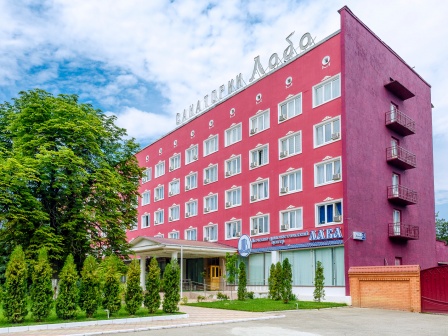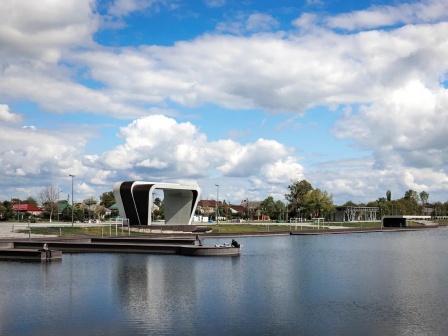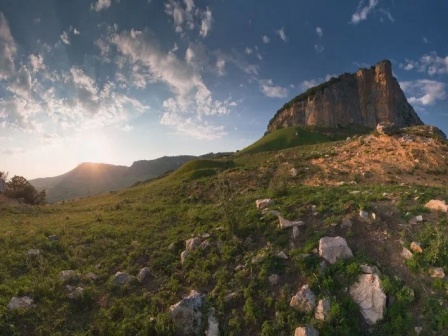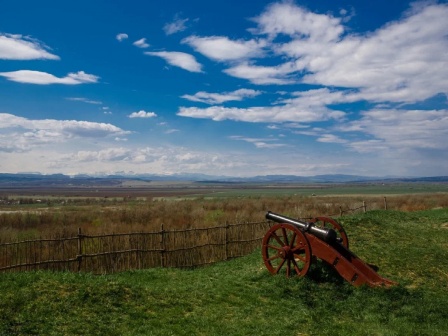Resource base
Climate
- The plain area has moderate humidity (humidity coefficient 0.3–0.4), while the foothills have good humidity (humidity coefficient 0.4–0.6) and experience high summer temperatures.
- The average annual air temperature is +10.5 °C (51 °F), the temperature of the coldest month (January) is −2.1 °C (28,4 °F), and the hottest (July) is +22 °C (51 °F). In some years, the minimum temperature can drop to 32 °C (−25 °F), and the maximum rises to +42 °C (107 °F).
- The average yearly rainfall is 669 mm, varying from 600 to 700 mm in the north and reaching up to 800 mm in the south. Rainfall is brief but intense during spring and summer, frequently accompanied by hail.
- The average yearly rainfall is 669 mm, varying from 600 to 700 mm in the north and reaching up to 800 mm in the south. Rainfall is brief but intense during spring and summer, frequently accompanied by hail.
- The prevailing winds mainly come from the east and southeast. The eastern winds are hazardous, reaching speeds of 15–16 m/s and higher, sometimes transforming into dust storms with speeds of up to 40 m/s.
- The climate is suitable for agriculture.
Mineral
resources
Fresh water
reserves
- There are about 17,000 hectares of water channels in Labinsk district.
- The Laba river is the main tributary of the Kuban river. It starts at the point where the Big and Little Laba rivers meet. The Laba river itself spans 214 km, while its total length, including its tributaries, is 341 km. The overall catchment area of the Laba river is 12,500 km2.
- The glaciers that feed the Laba river cover approximately 15 square kilometers. The Laba river is fed by a total of 4,776 large and small tributaries, with a combined length of 10,500 kilometers.
- The total catchment area covers 12,500 square kilometers.
Fertile
lands
- In the area between the Laba and Urup rivers, you can find black soils known as leached low-humus thick chernozems. These soils are highly fertile compared to others in the region.
- The soil profile thickness reaches 120 cm, with fertility extending up to 0.50 m. The humus content in the A horizon ranges from 4.0% to 4.6%, with humus reserves reaching up to 700 tonnes per hectare. The mechanical composition is mainly heavy loamy.
Recreational resources
- Sanatorium with mineral water springs
- Krugloye Lake regional natural monument
- Chistye Prudy Beach
- Akhmet Mountain
- A cultural heritage object of federal significance is the Progon Settlement (Mound), dating from the Bronze Age to the Middle Ages, a monument

Sanatorium with mineral water springs
Within the city limits of Labinsk, there is a year-round Laba anatorium. It is listed among the top health resorts in Krasnodar region and is built upon thermal springs. Currently, the area is actively utilizing a natural deposit of table hydrocarbonate-sodium water with mineralization and salt composition comparable to the renowned Baden-Baden mineral water.
On the grounds of AO Sanatorium Laba, there are two wells used for extracting mineral water. Water well 1-L BIS is 2,270 meters deep, with water reaching a high temperature of 104 degrees Celsius (219 °F) and a high mineral content of 13 grams per liter. The water contains elements such as sodium chloride, iodobromic, orthoboric, and siliceous, and is specifically meant for external use. Well 2-L, with a depth of 450 meters, provides slightly mineralized water at 1.08 grams per liter, with a temperature of 28 degrees Celsius (82 °F), and contains hydrocarbonate-sodium, serving as therapeutic table water.
Krugloye Lake regional natural monument
Krugloye Lake in Labinsk district is situated 6 kilometers southeast of Akhmetrovskaya village and 750 meters from the edge of Gornoe village, on the Chernomorsky ridge, at an elevation of 790 meters.
Krugloye Lake was formed at the bottom of a deep karst sinkhole.
The lake is 18 meters deep, 241 meters long, and 123 meters wide.
The lake’s water is exceptionally clear, allowing visibility of the bottom at a depth of 6 meters. It is supplied by both underground and surface sources. The water contains a small amount of hydrogen sulfide, giving it some healing properties.
The sinkhole’s significant size, depth, flat bottom, and the existence of coastal underwater terraces suggest that the lake has an ancient origin dating back to the Jurassic period.
Krugloye Lake is designated as a hydrogeological natural monument and is listed in the registry of specially protected areas in Krasnodar region.
There are fish and crayfish in the lake.
On the slope of the lake, there is a spring with clean mineralized water.
There are two caves near the lake. One entrance to the cave is situated on the path around the lake from the northwest side. The tunnel inside the cave extends for 20 meters before descending 7 meters deep, requiring ropes and equipment for exploration. Inside the cave, there are numerous passages, crevices, and halls, including a small canyon with a stone bridge.
From the southwest side, the shore of Lake Krugloe slopes.
There are walnut, beech, hornbeam, oak, hawthorn, herbs like St. John’s Wort, fern, and sage, comprising the complete range of trees and plants found in the Caucasian forest.
The northern and northeastern shores are steep and high.
Residents of Labinsk district like to visit the lake. A great place to relax.
Holidaymakers visit the sanatorium Laba for its healing waters and also explore this tourist attraction.

Chistye Prudy Beach
Chistye Prudy beach is located on the territory of Labinsk. It is a place with a lovely atmosphere, abundant greenery, beautiful installations, picturesque alleys, and playgrounds. All these features make the park an excellent spot for family outings.

Akhmet Mountain
A 786-meter mountain located on the right bank of the Big Laba river near Akhmetovskaya village is known for its historical significance. The name of the mountain originates from stories of it being used as a lookout and signaling point. However, a more romantic legend tells of the mountain being named after the courageous warrior Akhmet. In 1547, during the Turkish rule over the Caucasus, Akhmet, a warrior under a local prince, bravely rebelled against the Turkish invaders. Leading a small group, he carried out successful operations until he was eventually defeated. Akhmet and the remaining members of his group sought refuge in a forest near a towering mountain that overlooked the valley. There was a traitor in the detachment who revealed the highlander’s location to the Turks, leading to a fierce battle, which was long and bloody. As the only soldier left, Akhmet decided to escape. He quickly directed his horse towards a cliff edge to avoid capture by the Janissaries. To prevent his horse from being scared, he covered its eyes with a cloth. The horse, unaware of the danger, plunged off the 200-meter-high cliff. The pursuers, unable to halt their horses, continued their chase after the courageous young man.

A cultural heritage object of federal significance is the Progon settlement (Mound), dating from the Bronze Age to the Middle Ages, a monument
The Progon settlement is situated 2.5 km northwest of Kaladzhinskaya village, on a hill near the motorway connecting Zassovskaya and Kaladzhinskaya villages. Positioned atop the mountain, the settlement is surrounded by field vegetation, with the northern and western areas being particularly overgrown. The southern, western, and eastern sections of the settlement feature steep natural slopes. Its shape is irregular, extending from northwest to southeast. Accessible only from the northern side, a modern dirt road leads to the hillfort. A modern metal cross stands in the southern part, while a round-shaped mound (citadel) is located in the western section. An earthen rampart runs along the southern, southeastern, and northeastern parts, bordered by a natural cliff. During a survey of the southern area of the hill fort, a farm pit containing animal bones and broken pottery was discovered in the collapsed and eroding rock.
The site dates back to the 9th – 7th centuries BC and the 8th – 10th centuries AD, with the Russian fortress built in the 19th century.
The historical settlements contain valuable information about various periods and cultures. This monument is crucial for studying the Bronze Age, Early Iron Age, Middle Ages, and the 19th century in the North-West Caucasus.
The monument 'Progon Settlement (Mound)' is listed in the Unified State Register of Cultural Heritage Sites as a historical and cultural monument of the Russian Federation.



